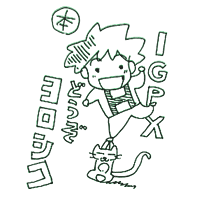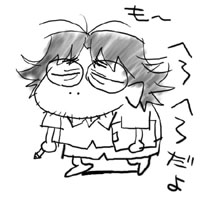Double Interview: Mitsuru Hongo & Toshihisa Kaiya
MITSURU HONGO interview

MITSURU HONGO profile
The black panther of the Japanese anime industry, Mitsuru Hongo always maintains good cheer. He is definitely the most modest animation director in Japan. His best known works include the world-famous Crayon Shin-chan (1992, the first historical director), and the TV series Chinpui (1989, director), Outlaw Star (1998, director), Kyoro-chan (1999, director), Candidate for Goddess (2000, director), Kasumin (2001, director). He also directed and wrote the screenplay for the feature film Sakura Wars: The Movie (2001).

Please tell us how you came to direct IGPX.
The first work I had the opportunity to do first-hand with Production I.G was as a supervising editor for a pilot film called Vampiyan - Just kidding. Later, I accepted an offer from somewhere else to direct a feature film, but this project was halted for some reason. It was then that Mr. Ishikawa offered me to work on the TV series IGPX.
Can you tell me about the collaboration with the Cartoon Network?
Before I joined the team, I.G had already made a 5 x 5' mini series for Cartoon Network. And they had decided to make a TV series based on it. In this pilot version, the storyline was a survival game of the IG machines, but I asked them to change it if I was to direct the series. So it was changed to a racing game to make the storyline clearer. I also changed the IG machine graphics from 2D to 3D. We had several discussions with the US staff from Cartoon Network on how to make the series more fun and thrilling. And the result is what we have now.
It's basically a "collaborative work" with an overseas company. What surprised me was that the communication with our US counterparts went very well, and, to tell you the truth, it was far easier to work on this project than some of the typical made-in-Japan anime I had made in the past. Usually when a lot of people work on one project, we tend to face all sorts of problems. In this project, there are neither agents nor original authors. That means I come up with a story and I talk with the Americans directly. It's that simple. Although we are from different countries, this is a small group of people who are committed to making an "entertaining anime" and it's working very well.
What are the new challenges for this project compared to past I.G anime?
I never relate to or make comparisons with other anime when I work on a new project. My main concern is to make an anime that's purely entertaining to watch for the general public.
What are the features that you want people to watch out for in IGPX?
Initially, IGPX was going to be a 13-episode series. We decided to recreate a whole season (i.e. one year) of racing, so people could watch one full racing season in one series. That's why we have this format. Then luckily, while we were still working on it, someone suggested we should make it a 26-episode series. So we decided to do a second full racing season following the first season. So just like the real motor sports, people can follow wins and losses as well as conflicts taking place over the years.
If I may point out, I tried to portray not only the main character Takeshi as mature, but also activities of unique characters such as Coach Andrei and River, Team Satomi second forward pilot. You will see some surprises in the story. These unique characters behave independently and really expand the story.
Any message to the fans waiting for the broadcast?
All of us are working hard to "show you a fun-filled anime!" IGPX is a simple and typical story of "a brave and hardworking adolescent boy who goes on an adventure and reveals his interest in girls along the way." We just want people to enjoy it. I hope you will like our brand new anime.
TOSHIHISA KAIYA interview

TOSHIHISA KAIYA profile
Born on June 1, 1967, Toshihisa Kaiya joined Asia-Do as an inbetweener in 1986. He debuted as a key animator for the TV anime Moeru! Oniisan (1988). Miracle Girls for TV (1993) was his first work as an animation supervisor. After he became a freelancer he worked in the feature films Jin-Roh (2000, key animator) and Mind Game (2004, key animator); and also in the games Kisetsu wo Dakishimete (2001, animation supervisor) and Surveillance (2002, character design and animation director.) He likes Japanese ghost stories. He especially worships Junji Inagawa, an actor famous for his ghost storytelling.

Q: Can you talk about how you came to take on the job as a character designer for IGPX?
A: I have participated in Production I.G's anime productions since Jin-Roh. I think they liked the work I've done for I.G since then and Mr. Terakawa, the producer, offered me a character design job for IGPX.
What are the steps you take in designing characters?
First, I read the script and expand my own image of the characters. Before starting my work, I got some ideas from the director, but he let me go my way from there. So I experimented extensively in order to transform my earlier styles a little bit. It was very difficult at first to decide how we were going to do this, but once it was decided, things went well. It seems like the designs resembled the style I was used to after all.
Compared with the rough drawings from the initial stage, many things have changed. But Takeshi, the main character, has stayed the same: a carefree type. But when we started moving him, he was quicker and livelier to our surprise, so we had to make minor changes to come up with the present design.
Which character do you like the most in IGPX?
I like Himawari in the medical team. She doesn't make a lot of appearances, but the animators are making sure she looks cute every time.
On the other hand, I had the hardest time with Fantine in Team Skylark. She is one of the main female characters, so the director ordered us to make her "the prettiest". Although I put a lot of effort into it, she ended up looking unattractive and I didn't know what to do.
The first time I forwarded the character draft, the director accepted it, but Hiroyuki Nishimura, who was collaborating in character settings, rejected it. He was in charge of the script, so I think he had clear images of the characters before the draft was made. The present designs came about by seeking opinions from many people.
In which character do you feel you have experimented the most?
Benjamin. He does the live-coverage of the races. I made his little finger of the hand holding the microphone stand straight up. I had never done this type of drawing in my life.
And they said my female characters were not sexy enough. The director advised me to let "the belly-buttons out!" I tried skimpier costumes. I researched magazines from overseas and intended to make them look fancier too.
Can you talk about key animation supervising?
At the moment, for IGPX, I am supervising episodes 1, 5, 9 and 13. This is the first time I joined the animation supervising rotation throughout the entire series. I am also working on original drawings for publicity and other copyrighted materials. I hope fans will enjoy the images of the characters and the atmosphere of the program depicted in these drawings that are not from the actual footage.
Any message to the fans who are eagerly anticipating the broadcast?
We are having a good time working on IGPX, so I hope the fans would simply enjoy the program as well.

![WORK LIST[DETAILS]](/contents/works/design/images/left_title.gif)



 terms of use
terms of use